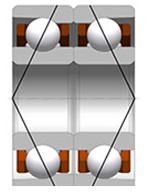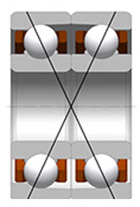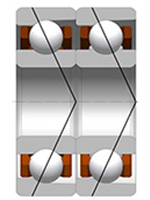Assembly of Bearing Sets
Bearing sets are used to greatly increase radial and axial rigidity. Bearing pairs can be arranged back-to-back (DB) or face-to-face (DF) to withstand bi-directional thrust loads, or tandem (DT) to withstand heavy uni-directional thrust loads.
Back-to-back arrangement (DB):When the bearings are mounted and the inner rings clamped together, the load lines (lines through points of ball contact) converge outside the bearings (forming an 'O'), resulting in increased moment rigidity. Inner ring abutting faces of DB duplex bearings are relieved. The axial force is absorbed in both directions. This configuration is suited for most applications, having good alignment of bearing housings and shafts. It is also preferable where high moment rigidity is required, and where the shaft runs warmer than the housing. |
|
Face-to-face arrangement (DF):When the bearings are mounted and the outer rings clamped together, the load lines converge toward the bore (forming an 'X'). the outer ring abutting faces of DF duplex bearings are relieved. The axial force is absorbed in both directions. DF mounting is used in few applications - mainly where misalignment must be accommodated. This arrangement has less tilting rigidity and as such, speed capability is usually lower than a DB pair of identical preload. |
|
Tandem arrangement (DT):Abutting faces of DT pairs have equal offsets, creating parallel load lines. When mounted and preloaded by thrust forces, both bearings share the load equally. DT pairs offer greater capacity without increasing bearing size, through load sharing - the axial load capacity is twice that of a single bearing. They can counter heavy thrust loadsbut only from one direction and they cannot take reversing loads as DB and DF pairs can. To combat this, DT pairs are usually opposed by another DT pair or a single bearing. |
|
Universal design (U):Universally preloaded bearings can be packed as sets 2UL, 3UL etc. This means the bore and outer diameter are in the same calibration group to ensure each bearing bears the same load. |


